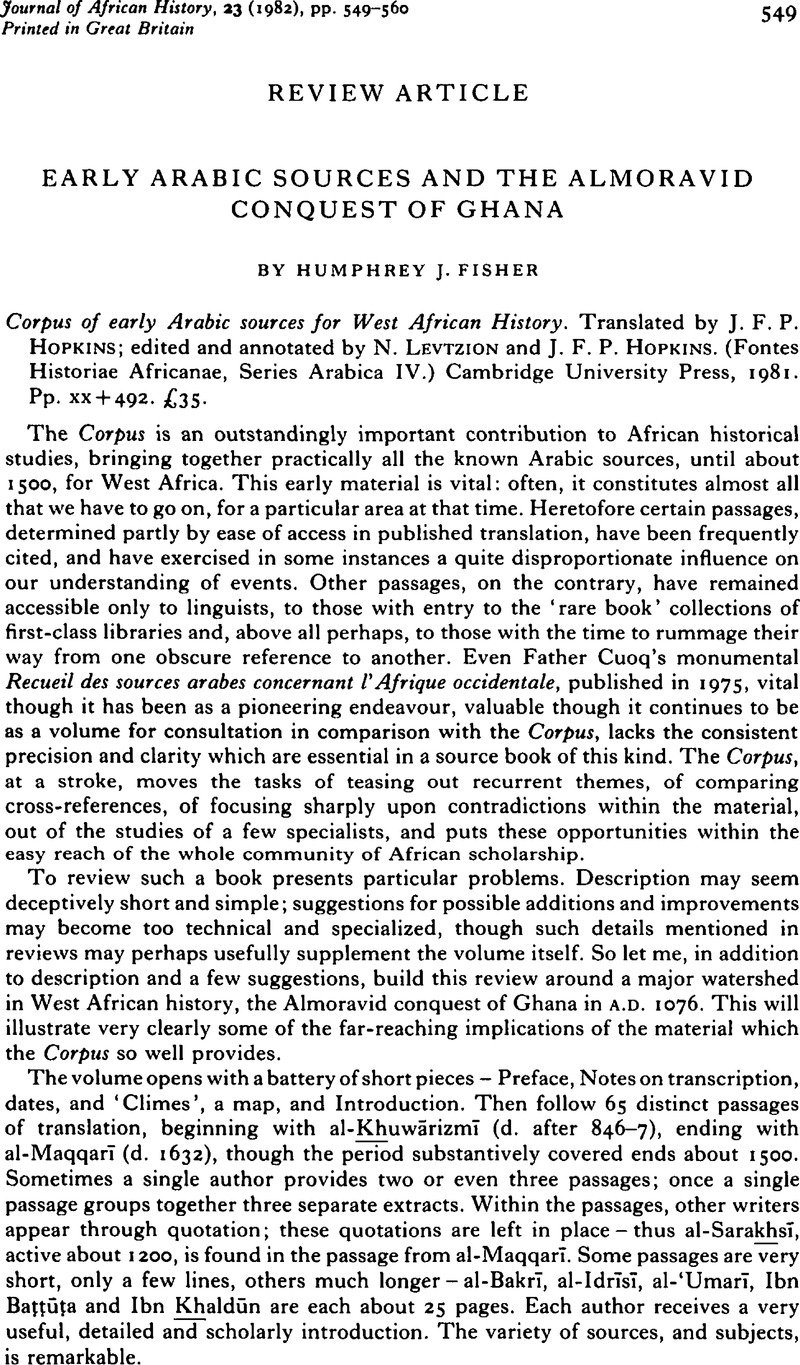Published online by Cambridge University Press: 22 January 2009

1 Trimingham, J. S., A History of Islam in West Africa (London, 1962), 29–30Google Scholar; comparable generalizations may be found in many other secondary sources.
2 For a still more convoluted attempt to fit al-Zuhrī into the conquest hypothesis, involving mistranslation and speculation about une confusion de noms et probablement aussi de tribus, see Cuoq, J. M., Recueil des sources arabes concernant l'Afrique occidentale (Paris, 1975), 119.Google Scholar
3 al-dīn ibn al-Khaṭīb, Lisān, Iḥāṭah fī akhbār Gharnāṭah (Cairo, 1973), 1, 404–9Google Scholar; the Corpus draws upon this work, but not this passage (see pp. 306–8).
4 Muḥḥammad Ibn ʿIdhārī al-Marrākushī, Abū'l-‘Abbās Aḥmad b., Kitālb al-bayān al-mughrib fī afhbār al-andalus wa'l-maghrib (Beirut, 1967), ed. Abbas, Iḥsān, iv, 25.Google Scholar
5 The printed Arabic gives desert, in the singular; but the Corpus uses also the original manuscript.
6 The Corpus gives one index reference, 217, a mistake; there may be a passing mention, in the context of black troops in Spain, but the reading seems doubtful – see Miranda, A. Huici, Al-Bayān al-mugrib…por ibn ʿIdārīal-Marrākusī (Tetuan, 1953–1954), I, 150 n.Google Scholar
7 Lévi-Provençal, E., Fragments historiques sur les Berberes au moyen-âge (Rabat, 1934), 2.Google Scholar
8 Cuoq, , Recueil, 248–54.Google Scholar
9 Ṣubḥ al-a'shā (Cairo, 1913–1920), v, 284Google Scholar; or Cuoq, , Recueil, 372.Google Scholar
10 Lange, D., ‘Un texte de Maqrīzīsur “Les races des Sūdān’”, Annates islamologiques, xv, (1979), particularly 188–90.Google Scholar
11 This same passage places the first conversion of the Almoravids in the first quarter of the second Islamic century; might this be the origin of the apparent ‘early conversion’ references in Ibn Khaldūn and al-Qalqashandī?.
12 In Ajayi, J. F. A. and Crowder, M., eds., History of West Africa, I (London, 1971), 168 n.Google Scholar
13 The effect of such tacit assumptions upon historical interpretation of this area and period has been perceptively discussed by de Moraes Farias, P. F., ‘Great states revisited’, J. Afr. Hist, xv, iii (1974), 470–88.Google Scholar
14 Levtzion, N., ‘The twelfth-century anonymous Kitāb al-istibṣār: a history of a text’, Journal of Semitic Studies, xxiv, ii (1979), 214–15Google Scholar, comparing the Kitāb with al-Bakrī, remarks that the former ‘was aware of the advance of Islam in the Western Sudan’ since al-Bakrī's time, and revised some of al-Bakrī's wording accordingly (see p. 552 above). This fits exactly with the argument of this review article; but Levtzion adds that the Kitāb thus ‘reflects the twelfth-century view which stressed the important role of the Almoravids in advancing the cause of Islam in the Western Sudan’. In my opinion, the emphasis specifically upon the Almoravids is more a fourteenth- than a twelfth-century phenomenon.
15 An exception is the unjustly neglected article of Coulibaly, M., ‘L'attaque de Ghana (Xle siècle)‘, Afrika Zamani (Yaoundé), ii, (04 1974), 55–7.Google Scholar Much of the evidence and argument in the present review article, conjoined with material from the oral traditions, is examined in greater detail in D. C. Conrad and H. J. Fisher, ‘The conquest that never was: Ghana and the Almoravids, 1076’, part i of which will appear in History in Africa (1982).